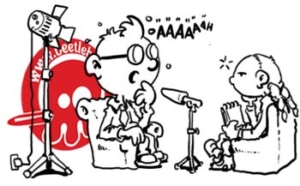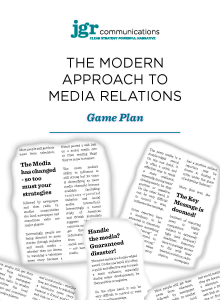News media interviews are often nerve-racking.  Someone is asking you questions (any question they want really) and is either writing down various things you say or is recording every word. Still, spokespeople shouldn’t fear media interviews because every single one of them is an opportunity. Some media interviews are clear opportunities for you (or the organization that you represent) to demonstrate the value of your work or contribution. Other times, interviews are based on industry issues or trends, or even controversies to which you are directly or indirectly involved. Either way, you are doing the right thing and the media interview should be an opportunity for you to demonstrate that.
Someone is asking you questions (any question they want really) and is either writing down various things you say or is recording every word. Still, spokespeople shouldn’t fear media interviews because every single one of them is an opportunity. Some media interviews are clear opportunities for you (or the organization that you represent) to demonstrate the value of your work or contribution. Other times, interviews are based on industry issues or trends, or even controversies to which you are directly or indirectly involved. Either way, you are doing the right thing and the media interview should be an opportunity for you to demonstrate that.
But what if they only ask you questions about the other things you’re involved in? The more complicated things? The things that are hard to explain in a “sound bite” or things that could be perceived as negative by themselves? What if you have a great story to tell but you mess up the interview? What if the reporter doesn’t get it and interprets what you said out of context?
The best advice is to remind yourself that you know this topic, that’s why you’re doing the interview (if you don’t know the topic – please find someone who does). Whether you are representing yourself, or your organization, you have been selected and it’s time to show that you know your stuff. Here are some best practices for delivering a great interview:
- Be concise: Know your points and get to them quickly. Most media interviews only last a few
minutes, so use your time wisely - Be strategic: It’s okay to talk about your company and its products, but only when appropriate. Don’t advertise a clothing sale during a hurricane (as one company did in 2012)
- Be honest: Don’t lie or refer to statistics you can’t support. Don’t exaggerate and don’t “spin.” It’s okay to say, “I don’t know” but if appropriate, tell them you will find the answer
- Be engaging: Be sure to pause after each point to allow the interviewer to engage in the conversation. This will also prevent viewers and listeners from tuning out
- Be careful: Know that everything you say is on the record and can be part of the story. Avoid making statements that can be easily manipulated or taken out of context
- Be conversational: Talk directly to the reporter, not to the camera. Also, avoid using jargon or acronyms that might confuse the audience
- Be confident: Use expression, but avoid nervous behaviours such as swaying, touching your face or blinking erratically; this can make you appear untrustworthy
- Be dressed for success: Dress appropriately. A typical newspaper, radio or blog interview will probably be done by phone, but if it is in-person, look professional. If it’s for TV, pay attention to bright colours and busy patterns that might be distracting on camera. No dangly jewellery
- Have a friendly face: Don’t frown or appear upset. If the interview has a sad or negative tone to it, convey empathy. Otherwise show you’re interested in the topic and if appropriate – smile
Check out our new book “The Modern Approach to Media Relations – Game Plan” now available on Amazon
